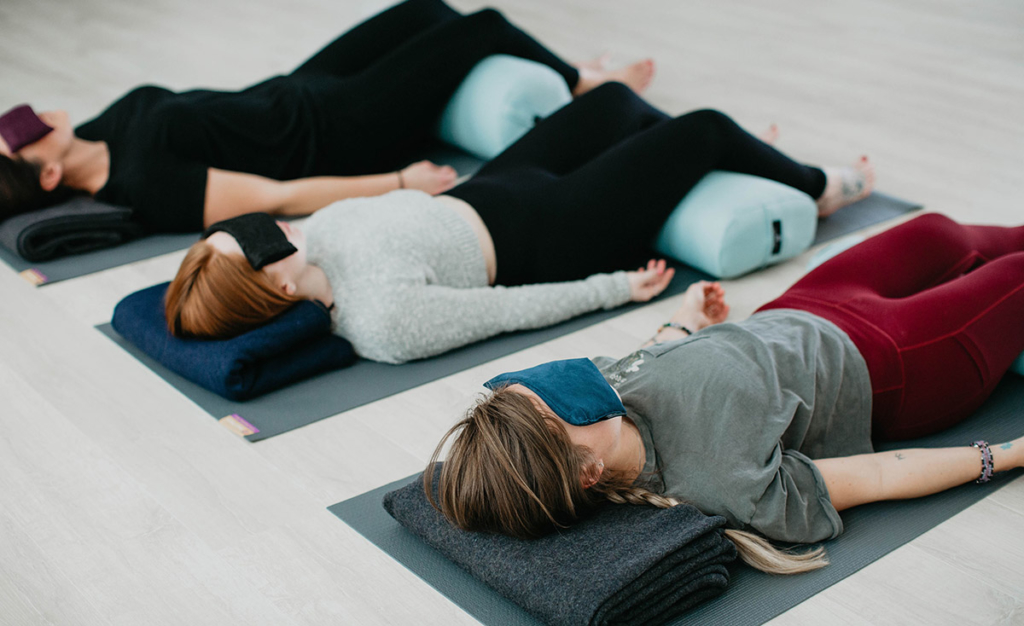
Breath awareness is foundational to mindfulness. In the practice, we choose an area of the breathing passage—the nostrils, chest or abdomen. Then we rest our attention in that place and observe the sensations of each inhalation and exhalation. Simple, right? Anyone who has practiced breath awareness knows that it may be simple, but it’s not easy. Our minds wander—a lot. This may be frustrating, but it’s absolutely normal. Sometimes it’s a challenge to get through even a single inhalation or exhalation before our minds spin out. But often, unbeknownst to us, the mind loses track in another, often overlooked, phase of the breath—the pause.
After each exhalation, there’s a pause. It might be short, a split second. Or it might be several seconds, depending on our own unique breathing rhythm. The pause can be shorter or longer depending on the state of our minds and bodies. Are we feeling anxious or agitated? Or are we feeling calm and concentrated? How does the state of the body/mind affect our breathing?
For example, when my mind is calm and concentrated, my in breaths and out breaths are minuscule. The pause after exhaling can be 15 to 20 seconds. This makes breath awareness much more challenging. There’s barely any inhalation or exhalation to be mindful of, and a whole lot of “down time” for my mind to wander elsewhere. So how do you practice breath awareness in this situation?
Be Mindful of the Pause
For me, the solution has been to recognize the pause as an equal part of the breath. This helps me to maintain continuity of awareness. But what is there to be mindful of when there’s no actual breathing? Actually, a lot. At any given moment, we’re pretty much being bombarded by sensation. All our senses are receiving input.
For example, during the pause, you could direct your attention to your sense of hearing. Or if there’s not a lot of sound in your current environment, you can pay attention to sensations of contact—your hips and legs in contact with your meditation cushion or chair; the contact of your clothing, or even the air around you, with your skin. Granted, some of these sensations might be subtle, but tuning into subtlety is part of practice.
You could also practice your breath awareness focusing on the larger frame of your whole body, rather than a particular spot in the breathing passage. You settle back into your body, aware of all the arising and passing sensations everywhere in your body. The inhalation and exhalation are simply two of the many sensations you experience. When you practice this way, the inhalation, exhalation and pause connect seamlessly. They’re all part of the same ever-changing tableau.
The Power in the Pause
So being aware of the pause helps you maintain more continuous awareness. But just as important, it gives you access to awareness itself. Pema Chodron famously said, “You are the sky. Everything else is just the weather.” What she’s pointing to is nothing less than our boundless nature. We are awareness. All the sensations that are constantly passing through awareness are the “weather.” But we tend to focus on the “weather” rather than the sky. Opening to the pause allows us to rest in awareness. We can begin to explore awareness itself—our true nature.
Practice Tips
Here are a few tips that might be helpful for settling into the pause:
- Start your practice with a body scan. Visit your whole body, one area at a time. You can start at the top of your head or the soles of your feet. For example, be aware of your facial muscles, scalp, brain, eyes, ears, jaw, teeth, tongue, throat, shoulders, upper arms, elbows, forearms, wrists, hands, ribcage, heart and lungs, diaphragm, abdomen, contents of the abdomen, low back, pelvis, hip joints, femurs, knees, lower legs, feet. You can, of course, reverse this, beginning with your feet. Starting with a body scan can help you tune into your body as a whole, so that you can experience your breathing from a wider perspective.
- Set intention. You may find it challenging to stay present during the pause. Giving attention to sensations in the body can seem unfocused, amorphous. Set an intention to stay continuously present—at the beginning of each inhalation, each exhalation, and each pause. While it may seem, at first, as if there’s nothing happening in the pause, look a little more closely. Settle back into your body, aware of whatever is arising. Be aware of the space around each sensation. Can you be aware of awareness itself?
- Practice in Savasana (Relaxation Pose). Allow yourself a 15- to 20-minute Savasana after your yoga practice. A longer Savasana gives your body time to achieve physiological relaxation, which takes 10 to 15 minutes. When your body is at rest, it’s easier for your mind to be at ease. The bit of wisdom I remember most from my study in India with B.K.S. Iyengar is when he said, “We practice asana so that we can create a calm, peaceful environment for the mind.” The state of spacious relaxation is quite literally the purpose of yoga asana practice.
